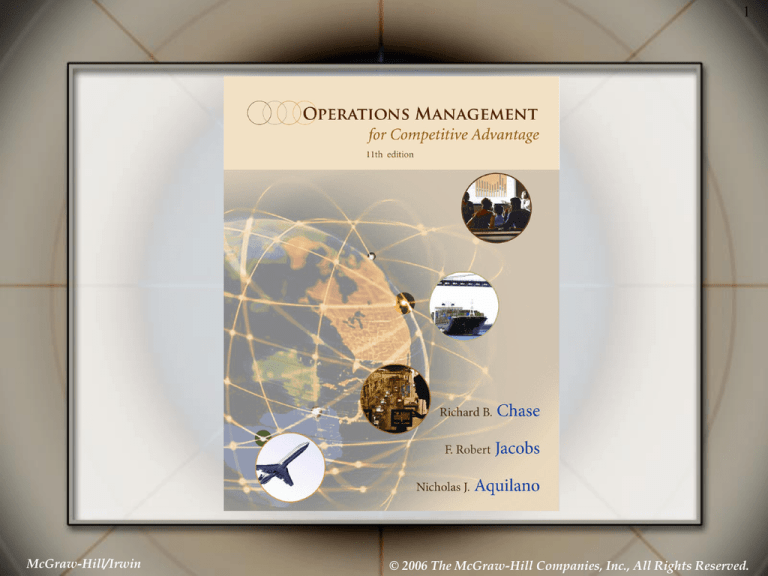
1
McGraw-Hill/Irwin
© 2006 The McGraw-Hill Companies, Inc., All Rights Reserved.
2
Chapter 5
Process Analysis
McGraw-Hill/Irwin
© 2006 The McGraw-Hill Companies, Inc., All Rights Reserved.
3
OBJECTIVES
Process Analysis
Process Flowcharting
Types of Processes
Process Performance Metrics
McGraw-Hill/Irwin
© 2006 The McGraw-Hill Companies, Inc., All Rights Reserved.
4
Process Analysis Terms
Process: Is any part of an organization
that takes inputs and transforms them
into outputs
Cycle Time: Is the average successive
time between completions of
successive units
Utilization: Is the ratio of the time that a
resource is actually activated relative to
the time that it is available for use
McGraw-Hill/Irwin
© 2006 The McGraw-Hill Companies, Inc., All Rights Reserved.
5
Process Flowcharting
Defined
Process flowcharting is the use of a
diagram to present the major elements
of a process
The basic elements can include tasks or
operations, flows of materials or
customers, decision points, and storage
areas or queues
It is an ideal methodology by which to
begin analyzing a process
McGraw-Hill/Irwin
© 2006 The McGraw-Hill Companies, Inc., All Rights Reserved.
6
Flowchart Symbols
Purpose and Examples
Tasks or operations
Decision Points
McGraw-Hill/Irwin
Examples: Giving an
admission ticket to a
customer, installing a
engine in a car, etc.
Examples: How much
change should be
given to a customer,
which wrench should
be used, etc.
© 2006 The McGraw-Hill Companies, Inc., All Rights Reserved.
7
Flowchart Symbols
Purpose and Examples
McGraw-Hill/Irwin
Storage areas or
queues
Examples: Sheds,
lines of people waiting
for a service, etc.
Flows of
materials or
customers
Examples: Customers
moving to a seat,
mechanic getting a
tool, etc.
© 2006 The McGraw-Hill Companies, Inc., All Rights Reserved.
8
Example: Flowchart of Student
Going to School
Go to
school
today?
Yes
Drive to
school
Walk to
class
No
Goof
off
McGraw-Hill/Irwin
© 2006 The McGraw-Hill Companies, Inc., All Rights Reserved.
9
Types of Processes
Single-stage Process
Stage 1
Multi-stage Process
Stage 1
McGraw-Hill/Irwin
Stage 2
Stage 3
© 2006 The McGraw-Hill Companies, Inc., All Rights Reserved.
10
Types of Processes (Continued)
A buffer refers to a storage area between
stages where the output of a stage is placed
prior to being used in a downstream stage
Multi-stage Process with Buffer
Buffer
Stage 1
McGraw-Hill/Irwin
Stage 2
© 2006 The McGraw-Hill Companies, Inc., All Rights Reserved.
Other Process Terminology
11
Blocking
– Occurs when the activities in a stage must stop
because there is no place to deposit the item just
completed
– If there is no room for an employee to place a unit of
work down, the employee will hold on to it not able
to continue working on the next unit
Starving
– Occurs when the activities in a stage must stop
because there is no work
– If an employee is waiting at a work station and no
work is coming to the employee to process, the
employee will remain idle until the next unit of work
comes
McGraw-Hill/Irwin
© 2006 The McGraw-Hill Companies, Inc., All Rights Reserved.
Other Process Terminology
(Continued)
12
Bottleneck
– Occurs when the limited capacity of a
process causes work to pile up or become
unevenly distributed in the flow of a
process
– If an employee works too slow in a multistage process, work will begin to pile up in
front of that employee. In this is case the
employee represents the limited capacity
causing the bottleneck.
Pacing
– Refers to the fixed timing of the movement
of items through the process
McGraw-Hill/Irwin
© 2006 The McGraw-Hill Companies, Inc., All Rights Reserved.
13
Other Types of Processes
Make-to-order
– Only activated in response to an actual order
– Both work-in-process and finished goods
inventory kept to a minimum
Make-to-stock
– Process activated to meet expected or
forecast demand
– Customer orders are served from target
stocking level
McGraw-Hill/Irwin
© 2006 The McGraw-Hill Companies, Inc., All Rights Reserved.
14
Process Performance Metrics
Operation time = Setup time + Run
time
Throughput time = Average time for a
unit to
move through the
system
Velocity = Throughput time
Value-added time
McGraw-Hill/Irwin
© 2006 The McGraw-Hill Companies, Inc., All Rights Reserved.
Process Performance Metrics
(Continued)
Cycle time = Average time between
completion of units
Throughput rate =
1
.
Cycle time
Efficiency = Actual output
Standard Output
McGraw-Hill/Irwin
15
© 2006 The McGraw-Hill Companies, Inc., All Rights Reserved.
Process Performance Metrics
(Continued)
Productivity = Output
Input
Utilization = Time Activated
Time Available
McGraw-Hill/Irwin
16
© 2006 The McGraw-Hill Companies, Inc., All Rights Reserved.
Cycle Time Example
17
Suppose you had to produce 600 units in 80
hours to meet the demand requirements of a
product. What is the cycle time to meet this
demand requirement?
Answer: There are 4,800 minutes (60
minutes/hour x 80 hours) in 80 hours. So the
average time between completions would have
to be: Cycle time = 4,800/600 units = 8 minutes.
McGraw-Hill/Irwin
© 2006 The McGraw-Hill Companies, Inc., All Rights Reserved.
Process Throughput Time
Reduction
Perform activities in parallel
Change the sequence of activities
Reduce interruptions
McGraw-Hill/Irwin
18
© 2006 The McGraw-Hill Companies, Inc., All Rights Reserved.
19
End of Chapter 5
McGraw-Hill/Irwin
© 2006 The McGraw-Hill Companies, Inc., All Rights Reserved.





